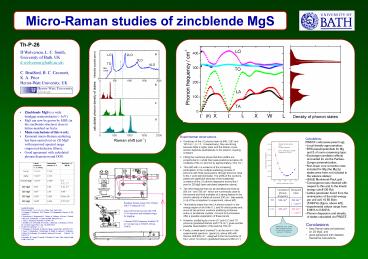aLandolt B - PowerPoint PPT Presentation
1 / 1
Title:
aLandolt B
Description:
c G Kalpana, B Palanivel, RM Thomas, M Rajagopalan, Physica B 222 (1996) 223 ... Leica DM LM microscope with OFR UV-B objectives and translation stage for mapping. ... – PowerPoint PPT presentation
Number of Views:62
Avg rating:3.0/5.0
Title: aLandolt B
1
Micro-Raman studies of zincblende MgS
Th-P-26
D Wolverson, L. C. Smith, University of Bath, UK
d.wolverson_at_bath.ac.uk C. Bradford, B. C.
Cavenett, K. A. Prior Heriot-Watt University, UK
- Zincblende MgS is a wide bandgap semiconductor
(5eV). - MgS can now be grown by MBE (in the zincblende
structure) close to lattice-matched on GaAs. - Main conclusions of this work
- Resonant micro-Raman scattering has been carried
out on ZB MgS with improved spectral range
(improved dielectric filters) - Good agreement with calculated phonon dispersion
and DOS.
- Experimental observations
- Overtones of the LO phonon seen at 849, 1261 and
1674 cm-1 (n 24 respectively) they are strong
because MgS is highly polar and the Raman
cross-section depends quadratically on the
polaron coupling constant - Fitting the overtones shows that their widths are
proportional to n whilst their peak positions lie
below nth multiples of the LO phonon by
approximately (15n) cm-1 - This shift with n is evidence of the increasing
participation in the multiple scattering process
of phonons with finite wavevectors (though
phonons close to the G point still dominate). The
shifts of the overtone peaks are significant
because of the substantial curvature of the LO
phonon dispersion around the G point in ZB MgS
(see calculated dispersion above). - The other features that can be identified are
those at 504 cm-1 and 759 cm-1 which are
numerically close to the second and third
multiples of a strong feature in the phonon
density of states at around 250 cm-1 (see panels
(c,d) of the comparison to experiment, above
left). - This feature arises from the LA phonon branch in
the energy region of all of the X, L and W
critical points and, since all two-phonon
overtone scattering is Raman-active in zincblende
crystals, 2LA and 3LA processes offer a possible
explanation of these bands. - However, scattering by a sum of G point LO and TO
phonons (predicted Raman shift 773 cm-1) gives
another possible interpretation of the band at
759 cm-1. - Finally, a weak band (marked ) can be see in in
the experimental spectrum (panel (a), above
left) with Raman shift 692 cm-1, assigned to the
2nd overtone of the G-point TO phonon (predicted
frequency 688 cm-1).
- Calculations
- PWSCF code (www.pwscf.org)
- Local density approximation
- BHS pseudopotentials for Mg and S of
norm-conserving type - Exchange-correlation effects accounted for via
the Perdew-Zunger parametrization - Non-linear core correction was included for Mg
(the Mg 2p states were here not included in the
valence states) - (6,6,6) Monkhorst-Pack grid
- Convergence was checked with respect to this and
to the kinetic energy cutoff (30 Ry) - Lattice parameter found from the minimization of
the total energy per unit cell 10.65 Bohr
(5.633ºA) (figure, above left) - experimental values range from 5.66ºA to 5.622ºA
- Phonon dispersion and density of states
calculated via PWSCF.
Calculated phonon frequency Measured value
TO 344 cm-1 344 cm-1 (1 cm-1)
LO 430 cm-1 429 cm-1 (1 cm-1)
a Landolt Börnstein b RWG Wyckoff, Crystal
Structure Wiley, New York 1963) c G Kalpana, B
Palanivel, RM Thomas, M Rajagopalan, Physica B
222 (1996) 223 d L Konczewicz, P Biegenwald, T
Cloitre, M Chibane, R Ricou, P Testud, O Briot,
RL Aulombard, J. Crystal Growth 159 (1996)
117 e C Verié, J. Electronic Materials 27 (1998)
782 f C Bradford, CB O'Donnell, B Urbszek, A
Balocchi, C Morhain, KA Prior, BC Cavenett, Appl.
Phys. Letts. 76 (2000) 3929 g For the NaCl
structure, d a/2 h Y Morinaga, H Okuyama, K
Akimoto Japan J. Appl. Phys. 32 (1993) 678 i U
Lunz, C Schumacher, J Nürnberger, K Schüll, A
Gerhard, U Schüssler, B Jobst, W Faschinger, G
Landwehr, Semicond. Sci. and Technol. 12 (1997)
970 j I Suemune, H Uesugi, H Suzuki, H Nashiki,
M Arita, Phys. Status Solidi B 202 (1997) 845
- Conclusions
- Best Raman data yet obtained on ZB MgS, and
- good agreement with detailed theoretical
calculations.
Agreement good - better than expected from the
LDA and linear response approach - fortuitous!

